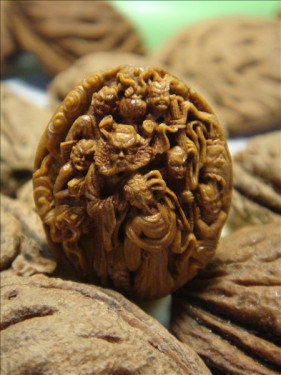 Nuclear carving is a folk traditional miniature carving process. It is a handicraft carved from cores such as peach kernels, apricot kernels, olive nucleus, and walnuts. Since ancient times, the number of people who love this art has been countless. From the emperors of the Ming and Qing dynasties to ministers of the princes and princes, from rich merchants to commoners, it can be said that their “fans†cover all classes. Ming Zhuzong Zhu Youxu wrote sculptures on his own hands, and Qing Emperor Qianlong was even more interested in nuclear carving. They hung small nuclear carvings between clothes, sashes, and embroidered bags to play as ornaments and embellishments, and presented them as gifts to others, highlighting their status and taste.
Nuclear carving is a folk traditional miniature carving process. It is a handicraft carved from cores such as peach kernels, apricot kernels, olive nucleus, and walnuts. Since ancient times, the number of people who love this art has been countless. From the emperors of the Ming and Qing dynasties to ministers of the princes and princes, from rich merchants to commoners, it can be said that their “fans†cover all classes. Ming Zhuzong Zhu Youxu wrote sculptures on his own hands, and Qing Emperor Qianlong was even more interested in nuclear carving. They hung small nuclear carvings between clothes, sashes, and embroidered bags to play as ornaments and embellishments, and presented them as gifts to others, highlighting their status and taste. The raw materials for nuclear carving include walnuts, peach kernels, olive nucleus, ivory kernels, apricot nucleus, cherry nucleus, etc. The best is olive nucleus, which is only as large as one finger. Carving on such a small olive nucleus is difficult to imagine. Due to its high degree of difficulty in operation, nuclear carving techniques have rarely been passed down.
According to records of historical records and cultural relics, nuclear carving has reached a very high level of art in the Ming Dynasty. During the Ming Xuande period, Xia Baiyan carved 16 children on the olive nucleus. Each child was only half a grain of rice and his eyebrows were clear. The most famous nucleus sculptor of the Ming Dynasty was Wang Yi of Yishan (now Shushan, the name of Shupingshan) in Jiangsu Lushan (now Changshu). The "boat of the Red Cliff" he created in the second year of Apocalypse (1622) is a treasure in the history of nuclear carving. The boat is about 3 cm (cm) long and about 0.5 cm high, and the cabin is in the middle. It is covered with a canopy, and a small window is opened next to it. Each of the four can be opened and closed. On the side of the window, on the right side of the window, there are “high mountains and small moons†and “water falling from the rocks†on the right, and the “fresh breeze is coming†and “the water is not shining†on the left. At the beginning of the ship, Su Dongpo and his close friends, Huang Luzhi and Buddhist and Indian monks, were among the three. Among them, Su Dongpo and Huang Luzhi both performed a book reading. The Buddhist and Indian monks, like Maitreya, had their breasts exposed, their left arms hanging beads, and their rosaries were countless. There is a stern stern, and the sculpted boatmen are left and right. The back of the boat: "Apocalypse Qiu Qiu Wang Yi Shu Shu far carved." Writings are as detailed as mosquitoes, and they are engraved with "Jing Ping Shanren." This nuclear boat has become a model for later masters of carving. "Dongpo Chibi rafting map" puts the nuclear carving art on the peak of history. The Ming Dynasty literary scholar Wei Xueyi wrote a book entitled "Nuclear Zhou Ji" in detail.
After the founding of New China, the "Nuclear Zhou Ji" was enrolled in the middle school textbooks. The nuclear boat was also passed on to China. Yixing sculptor Qiu Shan is skilled in Walnut nuclear sculpture. The themes are mostly Su Dongpo Chibi, Yujiale, Baihualan, and Shanshui. In the Qing Dynasty, the art level of nuclear carving further improved, with Jiangsu as a traditional production area. During the reign of Emperor Kangxi, Suzhou Jinlao (name is unknown), Jiading Feng Xilu, and Du Shiyuan and Shen Junyu during the Qian Long period were masters of nuclear carving. Feng Xilu's olive nucleus, "The Caoqiao Jingmeng" was carved. Houses and figures were properly arranged on the composition. They cooperated with Shuliu crows and Chaimen dogs to fully express the night scene in the countryside. Shen Junyu's olive nucleus engraves the “old hunched man†with a brown cap and beard. The shoulders of the clothes are patched. The fan is engraved with poetry on the shoulder. He uses the “Macaque Monkey†carved by the Yangmei nucleus. "Jinyu Trivia" records that some entertainers carved peach nucleus in a string of 108 rosary beads. Each rosary was engraved with 3 to 6 Arhats. Their postures were different, and their faces were identical. In addition, during the Jiaqing and Daoguang periods, the Dongpo Chibi, which was created by the famous stone carving master Fang Jianchao of Xiapu, Fujian Province, and the “Flood and Window Shutteringâ€, the gangue was portrayed by the Zhouzhong people as the world’s collectibles. In the best.
"Today's nuclear carving has inherited the exquisite traditional art of the predecessors, and also integrated the contents and techniques of the new era. It can be said that this ancient and magical folk art has been pushed to another peak." Suzhou nuclear carving artist Cheng Lijun Says, “Many of the nuclear sculptures that people knew in the past are mostly ancient figures. In recent years, the creators have combined more modern techniques, introduced new ones, designed the main landscape from a new perspective, and created the same dimensions. A more vivid and rich image."
Precision Glass Balls/Precision Glass Beads
Precision Glass Balls,Precision Glass Beads,Black Glass Ball
Crystal Fancy Stone Co., Ltd. , http://www.szglassbead.com